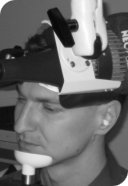Techniques
Our lab’s approach to research focuses on a pipeline which begins with behavioral experiments, and continues with brain imaging (fMRI) and brain stimulation (TMS / tDCS) experiments.
.
Behavioral Tasks
Each task we develop measures a unique characteristic of motor behavior or motor learning. A primary focus in the lab is the development of computer-based joint-action tasks. In each of these tasks, two of more individuals cooperate to acheive a specific goal.
.
functional Magnetic Resonance Imaging :: fMRI
MRI scans use radio signals to take pictures of the brain. fMRI is a type of MRI scan that is is sensitive to oxygenation concentration, allowing us to infer brain function. Typically, we have people perform simple motor tasks in the scanner while we collect fMRI scans. We have used this technique to identify the brain areas involved in imitation, social motor actions (i.e. teamwork, complementary action, motor simulation) and motor learning.
.
Transcranial Direct Current Stimulation :: tDCS
tDCS applies weak electrical currents to the scalp. It appears that tDCS can induce subtle changes in brain activity, with regions near the positive electrode showing slightly increased firing rates, whereas regions under the negative electrode show small decreases in firing rate. Curiously, these changes seem to persist for many minutes after the stimulation ends. Because this technique is very safe and inexpensive, this technique offers potential for the helping improve motor learning in healthy and impaired populations.
.
Transcranial Magnetic Stimulation :: TMS
TMS uses a brief magnetic pulse to stimulate parts of the brain near the TMS coil. The region of stimulation is relatively focused. By introducing TMS pulses while participants are conducting a task we can determine if the stimulated region is crucially responsible for performance on that task. Our TMS systems are supplied by MagVenture, a company based in Sweden.





